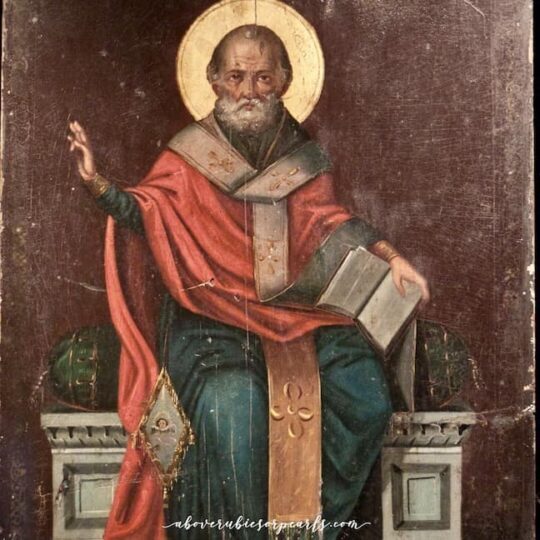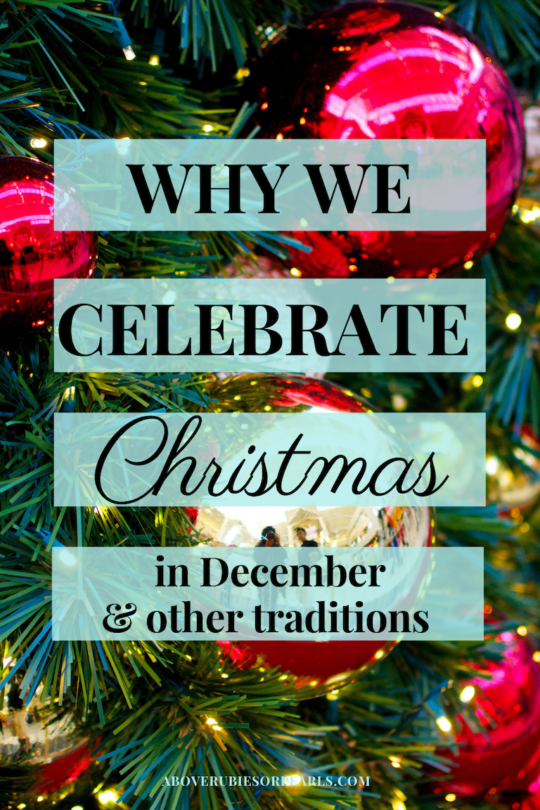I am so excited that it is almost Christmas! It is my favorite holiday. However, did you know that Jesus’ birthday is not actually December 25th, or even in December at all? We know this for three main reasons. One, the shepherds watching over their flocks when the angels announced His birth in Luke 2:7-8 indicates that it occurred during a warmer month. Two, the census that Mary and Joseph had to travel to Bethlehem for would not have occurred in December when it was cold. Three, Jesus’ cousin, John the Baptist, was conceived 6 months before Jesus, which would put Jesus’ birth in June. According to this article, it is believed His birth was between June 13th to 17th. Surprising, isn’t it?!
So why do we celebrate His birthday in December if it is really in June? The answer has to do with a desire to convert pagans to Christianity. Christmas was intentionally chosen to be celebrated on the same day of the popular holiday celebration of the winter solstice.
It seems that this desire to win pagans over to Christianity led to other pagan rituals being added to the celebration of Christmas.
See Related: Ways to Bless Your Community
History of the Christmas Tree

Every year, I get a live Christmas tree, primarily because having one reminds me of happy childhood memories. But Americans did not always decorate trees for Christmas. Americans did not begin buying Christmas trees until 1850 after Queen Victoria popularized the practice when a drawing of “The Queen’s Christmas Tree at Windsor Castle” appeared in the London News in 1848. It is believed that German settlers spread the practice across the United Kingdom and the United States.
The Legend of the Christmas Tree
There are two legends for how the Christmas tree began to symbolize Christianity. In one legend, Boniface, an English Benedictine monk chopped down an oak tree to stop some native Germans performing sacrifices from worshiping a false idol. It is believed that when he was not struck by lightning like the pagans thought he would, Boniface used that as an opportunity to convert them to Christianity. According to the legend, a fir tree grew out of the fallen oak. It’s shape of three sides, representing the trinity, became a symbol of Christ and is credited as the origin of the Christmas tree and bringing it inside.
However, another legend credits Martin Luther, a German preacher, as the first person to bring a Christmas tree inside and decorating them with lights. As the story goes, he was reminded of Jesus one night when he saw the stars twinkling between the branches of an evergreen while out walking one Christmas Eve night and wanted to recreate it.
Which one of these legends do you believe to be true?
The History of Christmas Lights
In addition to how great Christmas trees smell, I also love gazing at their lights when they are all decorated! 😍 The first person known to use Christmas lights was a colleague of Thomas Edison, Edward Johnson, when in 1882, he decorated his tree with 80 red, white, and blue bulbs strung together. However, at $300, Edison’s services for electric Christmas lights were too expensive for most Americans when they first became available in 1890. The first affordable lights didn’t become available until 1903 when they were $12 for a string of 24 (still very expensive!) or you could rent them for $1.50. So people used candles to light their trees! This was very dangerous, so insurance companies tried in 1908 to get a law passed to ban the use of candles on Christmas trees. Fortunately, President Grover Cleveland used electric lights on the tree in the White House for his daughters because he popularized their use.
The Meaning of The Tree Topper
When I was a teacher, I received the most beautiful angel tree topper and angel ornaments as gifts from my students over the years. I had to leave them back in Michigan while I got settled in California. Angels are popular ornaments and one of the main two symbols of Christianity that we use for tree toppers. The angel represents the angel that told the shepherds about the birth of Jesus. The other Christian tree topper is a star. We top our trees with a star because the Star of Bethlehem was what the Wise Men saw and followed to find Baby Jesus.
The Legend of Candy Canes

Do you ever wonder what candy canes have to do with Christmas? According to legend, a candy maker wanted to make a candy that symbolized the true reason we celebrate Christmas: Jesus. He chose a hard candy and shaped it like a J to represent Jesus, the rock of all ages. The color white represents the pureness of Jesus and the color red, the blood He shed to save us from our sins. Every time you see a candy cane, we should take the time to remember Who we are celebrating.
The Holly Wreath
Even though I love to, this year I did not get a wreath. This is because I would hardly get to see it during this pandemic. I may change my mind, though, because wreaths are so beautiful. Did you know that the wreath represents the crown of thorns worn by Jesus at Calvary? The red berries represent the shed blood of Jesus for the forgiveness of our sins. Its shape of a circle represent eternal life because it is never ending.
The Origins & Legend of Santa Claus
Like many children, I definitely believed in Santa Claus, even though I also knew that Christmas was about Jesus. Santa brought the toys to celebrate Jesus’ birthday, right? How exactly did Santa get invited into a celebration about Jesus?

Santa Claus is a real person named Saint Nicholas, patron saint to children, believed to be born in third century Turkey. He became very well known for his kindness, generosity, and protection of children, especially after he saved three girls from being sold into slavery, according to one legend.
One of the most popular saints, his feast day was celebrated on the day of his death, December 6. In the late 1700s, the gathering together of some Dutch families to celebrate his feast day in New York was reported in the newspaper. Sinter Klaas, the Dutch nickname for Saint Nicholas and evolving into Santa Claus, was born.
In the 1800s, John Pintard and Washington Irving helped popularize St. Nicholas. The former by displaying images of St. Nicholas with stockings filled with goodies at the New York HIstorical Society. And the latter by including St. Nicholas in his book, The History of New York, as the patron saint of New York. By 1820, stores began to advertise Christmas shopping, which evolved into including images of Santa Claus. Our current image of a supernatural Santa comes from ‘Twas the Night Before Christmas, a poem written by an Episcopal minister, Clement Clark Moore, for his daughters in 1822. And in 1881, a political cartoonist, Thomas Nast, gave us our modern day image of a jolly Santa in a red suit and white beard.
Why We Give Gifts at Christmas
Giving and receiving gifts is one of the most enjoyable things about Christmas; it’s what makes Christmas morning so exciting! This tradition is in memory of the gifts the Three Wise Men brought to Jesus after He was born. Each of the gifts they gave to Baby Jesus has a special symbolism:
- Gold, for kings, acknowledged Jesus as the King of kings.
- Frankincense, used for worship, acknowledged that Jesus would be worshiped.
- Myrrh, used to prepare the dead for burial, signified that Jesus would suffer and die on our behalf.
The best gift, of course, is Jesus Himself, given to us by our Heavenly Father:
“For God so [greatly] loved and dearly prized the world, that He [even] gave His [One and] only begotten Son, so that whoever believes and trusts in Him [as Savior] shall not perish, but have eternal life.”
– John 3:16 AMP
He is the reason for the season and no better gift to receive! 🤩🙌🏽
Which of these traditions do you think we should keep? Any that we shouldn’t? Let me know your thoughts in the comments below!
Until next time, peace and joy to you all!

Pin it!














Love all this history. I do holidays around the world with my kids during this season and it’s so fun to see where all our traditions originated from.
What a great idea to do with children! Every time I came across research about how other countries celebrate Christmas, I was always so interested in reading it but had to remain focused on my topic. Thank you so much! I am glad you enjoyed this post. 🥰
Thank you for enlightening me sister.I enjoyed reading your blog. God bless🙏❤😘
You are welcome, and thank you so much for your comment, sis! I am so glad glad it was enlightening. 🥰
Wow this is such an awesome post thanks for the in depth history on Christmas! It’s interesting to see the origins of holidays and what it means to people now.
Thank you so much! And yes, it was definitely interesting learning how all of our customs started and how they have evolved and been embraced over the years.😊
Interesting and informative post .Thanks for sharing!
You are welcome! I am glad this was informative! 😊
Such a great way to share all the meanings behind the traditions that we now hold near and dear.
Thank you so much, Ayanna! I am glad you enjoyed this article. 🤗
Love this! Too often people forget that Christmas is way more than a commercial and eating/drinking binge! Beautifully written!
Thank you! And you are right about that; we need to remember what the holiday is really about AND how we came to celebrate it the way that we do today. 🥰
I really enjoyed this article. I have studied world religions and the fact that Jesus was born in June was something I was already aware of. One of the reasons why Christmas was celebrated in December vs. June is because there was a feast of lights celebration that was apart of the Zoroastrian religion, a competing pagan religion to Christianity. In order to convince the pagans that Christianity and the birth of Jesus was actually the way and the light, they created Christmas to be a similar celebration to the feast of lights in Zoroastrianism. Your article is timely in that it is the holiday season, and I think it’s important for us to reflect on why we are celebrating or engaging in the things we do. Is it just for tradition, is it because someone said so, or do we have a deep personal connection to the situation or event. Celebrating Christmas is one of those traditions that we can easily lose ourselves in and forget that there is a deeper meaning to all that we do. Good Stuff!
That is fascinating, Shanique. Thank you so much for sharing those details, and I could not agree with you more that we need to be more aware of Who the season is truly about and celebrate that instead of our traditions. 🤗
Great article! I loved learning about the history of all my favorite Christmas traditions.
Thank you, Kimberly! I am so glad you enjoyed my article. 🥰
I loved reading all the history of Christmas! I did know that Jesus’ birthday was not in December, but I didn’t know that it was thought to be in June.
Thank you, Tiffany! I am so glad you enjoyed reading my article. Yes, that was a fascinating detail! 😊
This is such a great post. I learned a few things about Christmas that I didn’t already know. So thank you for your thorough research and for sharing your findings with us!
You are welcome, Christina! Thank you, I am so pleased to hear that! 😊
[…] Why We Celebrate Christmas in December and Other Traditions – A fun but insightful blog post highlighting and explaining the origins of many of the Christmas traditions we participate in. […]
[…] See Related: Why We Celebrate Christmas in December and Other Traditions […]
[…] Why We Celebrate Christmas in December and Other Traditions […]